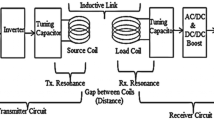Abstract
The design of contactless power supplies with inductive power transfer (IPT) is still a challenge even though such systems have become more and more established for various applications. This article presents an intuitive, educational introduction to IPT system design for practicing engineers who are new to the field. While following the path of the energy through the IPT system, the contactless power transfer is explained with a circuit-oriented approach, extended by an analysis of the field patterns and the energy flux across the air gap. Finite element method simulation results for the Poynting vector are shown to illustrate the power transfer process. Finally, a minimization of the reactive power demand of the IPT coils is performed, from which the general requirements for an efficiency optimal design of the IPT system can be intuitively understood.





Similar content being viewed by others
Abbreviations
- \(L_1\) :
-
Self-inductance of transmitter coil
- \(L_2\) :
-
Self-inductance of receiver coil
- M :
-
Mutual inductance of the IPT coils
- k :
-
Magnetic coupling of the IPT coils
- \(C_1\) :
-
Transmitter-side compensation capacitance
- \(C_2\) :
-
Receiver-side compensation capacitance
- \(\omega _0\) :
-
Resonant frequency
- \(U_\mathrm {1,DC}\) :
-
Transmitter-side DC input voltage
- \(U_\mathrm {2,DC}\) :
-
Receiver-side DC output voltage
- \(P_2\) :
-
Average output power
- \(R_\mathrm {L,eq}\) :
-
Equivalent load resistance
- \(i_1\) :
-
Transmitter coil current
- \(i_2\) :
-
Receiver coil current
- \(u_1\) :
-
Source voltage at transmitter
- \(u_2\) :
-
Load voltage at receiver
- \(p_\mathrm {L1}\) :
-
Input power to IPT coils
- \(p_\mathrm {L2}\) :
-
Output power of IPT coils
- \(q_\mathrm {L1}\) :
-
Reactive part of input power
- \(q_\mathrm {L2}\) :
-
Reactive part of output power
- \(\mathbf {E}\) :
-
Electric field
- \(\mathbf {H}\) :
-
Magnetic field
- \(\mathbf {S}\) :
-
Poynting vector
- \(\phi \) :
-
Electric potential
- \(\mathbf {A}\) :
-
Magnetic vector potential
- \(\upmu _0\) :
-
Vacuum permeability
- \(\upvarepsilon _0\) :
-
Vacuum permittivity
- \(w_\mathrm {m}\) :
-
Magnetic energy density
- \(w_\mathrm {e}\) :
-
Electric energy density
- \(w_\mathrm {tot}\) :
-
Total energy density
- \(W_\mathrm {m}\) :
-
Total magnetic energy
- \(W_\mathrm {tot}\) :
-
Total energy
References
Bocan K, Sejdić E (2016) Adaptive transcutaneous power transfer to implantable devices: a state of the art review. Sensors 16(3):393. doi:10.3390/s16030393
Bosshard R (2015) Multi-objective optimization of inductive power transfer systems for EV charging. Ph.D. thesis, ETH Zurich, Switzerland
Bosshard R, Kolar JW, Mühlethaler J, Stevanović I, Wunsch B, Canales F (2015) Modeling and \(\eta \)-\(\alpha \)-Pareto optimization of inductive power transfer coils for electric vehicles. IEEE J Emerg Select Topics Power Electron 3(1):50–64. doi:10.1109/JESTPE.2014.2311302
Brandão Faria JA (2012) Poynting vector flow analysis for contactless energy transfer in magnetic systems. IEEE Trans Power Electron 27(10):4292–4300. doi:10.1109/TPEL.2012.2191421
Choi S, Gu B, Jeong S, Rim C (2015) Advances in wireless power transfer systems for roadway-powered electric vehicles. IEEE J Emerg Select Topics Power Electron 3(1):18–36. doi:10.1109/JESTPE.2014.2343674
Covic G, Boys J (2013) Inductive power transfer. Proc IEEE 101(6):1276–1289. doi:10.1109/JPROC.2013.2244536
Diekhans T, De Doncker R (2015) A dual-side controlled inductive power transfer system optimized for large coupling factor variations and partial load. IEEE Trans Power Electron 30(11):6320–6328. doi:10.1109/TPEL.2015.2393912
Ferreira JA (1988) Application of the Poynting vector for power conditioning and conversion. IEEE Trans Educ 31(4):257–264. doi:10.1109/13.9751
Goeldi B, Reichert S, Tritschler J (2013) Design and dimensioning of a highly efficient 22 kW bidirectional inductive charger for e-mobility. In: Proceedings of the international exhibition and conference for power electronics (PCIM Europe). Nuremberg, DE, pp 1496–1503
Hui SY (2013) Planar wireless charging technology for portable electronic products and Qi. Proc IEEE 101(6):1290–1301. doi:10.1109/JPROC.2013.2246531
Hui SY, Zhong WX, Lee CK (2014) A critical review of recent progress in mid-range wireless power transfer. IEEE Trans Power Electron 29(9):4500–4511. doi:10.1109/TPEL.2013.2249670
Jackson JD (1998) Classical electrodynamics, 3rd edn. Wiley, Hoboken
Leuchtmann P (2005) Einführung in die elektromagnetische Feldtheorie, 1st edn. Pearson Studium, Munich
Schuder JC (2002) Powering an artificial heart: birth of the inductively coupled-radio frequency system in 1960. Artif Organs 26(11):909–915
Steigerwald R (1988) A comparison of half-bridge resonant converter topologies. IEEE Trans Power Electron 3(2):174–182. doi:10.1109/63.4347
van Schuylenbergh K, Puers R (2009) Inductive powering: basic theory and application to biomedical systems, 1 edn. Springer Science+Business Media, Dordrecht. doi:10.1007/978-90-481-2412-1
Waffenschmidt E, Staring T (2009) Limitation of inductive power transfer for consumer applications. In: Proceedings of the 13th European conference on power electronics and applications (EPE-ECCE Europe), Barcelona, ES, pp 1–10
Author information
Authors and Affiliations
Corresponding author
Rights and permissions
About this article
Cite this article
Bosshard, R., Guillod, T. & Kolar, J.W. Electromagnetic field patterns and energy flux of efficiency optimal inductive power transfer systems. Electr Eng 99, 969–977 (2017). https://doi.org/10.1007/s00202-016-0461-7
Received:
Accepted:
Published:
Issue Date:
DOI: https://doi.org/10.1007/s00202-016-0461-7




